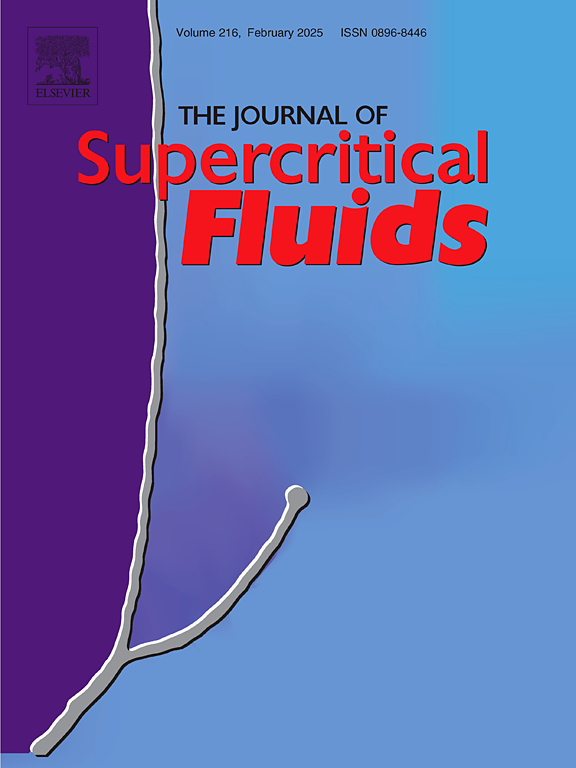验证水乙醇混合物作为悬浮介质/改性剂用于超临界二氧化碳萃取悬浮液的实验方法
IF 3.4
3区 工程技术
Q2 CHEMISTRY, PHYSICAL
引用次数: 0
摘要
我们开发了一种方法来研究直接从细微破碎基质悬浮液中萃取高价值溶质的过程。为此,我们利用实验文献数据模拟了三元(二氧化碳+乙醇+水)体系的高压相平衡。在静态萃取过程中,将不同成分的水乙醇混合物和二氧化碳装入萃取容器中,萃取容器的压力设定在 30-35 兆帕,温度设定在 40-50 °C;在动态萃取过程中,持续注入与萃取容器中富含二氧化碳的气相成分相同的气体混合物。进料氢乙醇混合物的损耗主要发生在动态萃取过程中(10-30 wt%),并根据实验流的实际流量和成分进行了适当分配。大多数情况下,在 2 小时的动态萃取过程中,经过约 1 小时就达到了平衡条件,并实现了良好的重现性。总之,萃取容器内的两相(富含水的液相和富含二氧化碳的气相)达到平衡共存。本文章由计算机程序翻译,如有差异,请以英文原文为准。
An experimental methodology to validate the use of hydroethanolic mixtures as suspending medium / modifier for the supercritical CO2 extraction of suspensions
We developed a methodology to study the extraction of high-value solutes directly from suspensions of finely disrupted substrates. For that, we modelled the high-pressure phase equilibrium for the ternary (CO2 + ethanol + water) system using experimental literature data. Different compositions of hydroethanolic mixture and CO2 were loaded into an extraction vessel set at 30–35 MPa and 40–50 °C during static extraction, and a gaseous mixture with the composition of the CO2-rich gaseous phase in the extraction vessel was continuously fed during dynamic extraction. Losses of the fed hydroethanolic mixture occurred mainly during dynamic extraction (10–30 wt%) and were properly distributed to account for actual flows and compositions of experimental streams. Mostly, equilibrium conditions were reached following about 1 h of the 2-h dynamic extraction, and good reproducibility was achieved. In conclusion, equilibrium is reached in which two phases coexist in equilibrium within the extraction vessel: a water-rich liquid phase and a CO2-rich gaseous phase.
求助全文
通过发布文献求助,成功后即可免费获取论文全文。
去求助
来源期刊

Journal of Supercritical Fluids
工程技术-工程:化工
CiteScore
7.60
自引率
10.30%
发文量
236
审稿时长
56 days
期刊介绍:
The Journal of Supercritical Fluids is an international journal devoted to the fundamental and applied aspects of supercritical fluids and processes. Its aim is to provide a focused platform for academic and industrial researchers to report their findings and to have ready access to the advances in this rapidly growing field. Its coverage is multidisciplinary and includes both basic and applied topics.
Thermodynamics and phase equilibria, reaction kinetics and rate processes, thermal and transport properties, and all topics related to processing such as separations (extraction, fractionation, purification, chromatography) nucleation and impregnation are within the scope. Accounts of specific engineering applications such as those encountered in food, fuel, natural products, minerals, pharmaceuticals and polymer industries are included. Topics related to high pressure equipment design, analytical techniques, sensors, and process control methodologies are also within the scope of the journal.
 求助内容:
求助内容: 应助结果提醒方式:
应助结果提醒方式:


